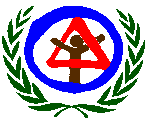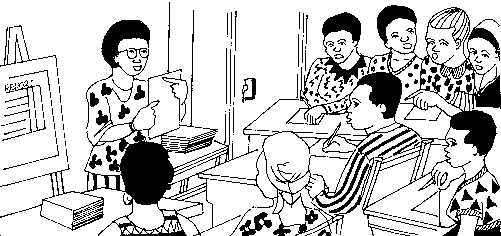 |
|
 |
|
The
nineteen outputs included in the CMP Uganda project document,
with
a few advisory notes (as of 1998 October).
by
Phil
Bartle
| These nineteen outputs are quoted directly from the CMP Uganda Project Document (ProDoc), signed between UNCHS (Habitat), UNDP and the Government of Uganda. They are numbered from 1.1 to 7, reflecting the seven immediate objectives of the project. The comments following each output are those of the author, and do not necessarily reflect the official policy of the Government of Uganda or UNCHS (Habitat). |
This is the primary output of CMP. Instead of "communities," it should be written "community members," who are trained. (Communities, as such, can not be trained, but they can be organized). Training here means mobilisation as well as skill transfer. The DPCs report on progress in this output every month. There are a variety of activities associated with this, including meetings, one-on-one discussions, and observations about indicators of results, that appear in District Coordinators' progress reports..
This was completed at an early stage. After initial training, further follow ups should be in the form of on-the-job training. Those who are trained are called upon by DPCs to practice their training. If there arises a further need for formal training, then the DPCs plan for training and justify it in a training proposal. A training proposal is more than a budget and a series of topics, it is a curriculum stating verifiable results..
This, also, was done in a formal way early in the programme, by DPCs, then followed up by informal supervision and on-the-job coaching. Should the need arise for another formal training, then a proposal is prepared by the DPC, justifying the need, and indicating verifiable results. Up to now there has been little cooperation with relevant NGOs, and more liaison is required..
This was done in a formal way by the first management of CMP, by hiring consultants to produce a baseline survey for each district. The results, some baseline surveys, have mainly sat on the shelves since they were done, only being examined by researchers from MISR when they began their research, and by a couple visitors sent to CMP from UNDP to examine CMP for whatever their purposes were. Unfortunately, the documents have not been used as an integral part of the planning and implementation of CMP on a routine basis, as they were intended to be. Perhaps the DPCs could read through each document (for their respective districts) and make some suggestions on how they could be used, and if and how each might be updated and/or made more useful as a planning tool..
This is an ongoing thing, related to the community facilities that are constructed in the process of strengthening communities. Not all 600 have been trained at once, but this is in response to a community first constructing a facility then wanting to participate in its maintenance. It should be a topic mentioned in each DPC's progress report. This management training can also be linked to the kind of private enterprise management training that is part of income generation by micro enterprise support..
This is where it is evident that the ProDoc was written by a consultant in 1991/2 without the kind of experience and observations we now have after five years of CMP-1. Now, instead of five enterprises per district as envisage in the ProDoc, we can have one umbrella group per parish, and five to seven trust groups per umbrella group (thirty five to fifty individual women entrepreneurs per umbrella group), thus 300-500 women getting MICRO loans to engage in their own micro (in the Grameen Bank sense) productive income-generating activities..
This has not been directly tackled yet by CMP Uganda. Kampala District, however, has done some good work in using the Ministries of Health and Agriculture to find ways of recycling garbage (as a form of income generation) in order to engage in urban farming. The raising of awareness about community health needs to be explored further by the PMT. CMP can form partnerships with urban CBOs and NGOs interested in the environment, and reducing urban pollution. How do we measure success or even completion in this output? How aware, for example should these 30 women be, and how would we test that?
This is an area where some of the districts have engaged in some activities, but we do not have a systematic record of everything that has been done. The DPCs should report upon what has taken place in each district in the past, and the National Office should compile that into a total picture to put in appropriate reports: eg the PPER and the half year report.
So far we have about ten community projects in process, some of which have been completed. This output is the most visible, and is the one that many people, including journalists and at least one Central Government Representative, judge the success or failure of CMP, especially those who do not recognise that capacity building, not facility construction, is the goal of CMP. This, like output 1.1, is a core output for CMP, and is reported upon by every DPC every month.
This output has been radically changed. In 1994, the PMT decided that choosing one household (and giving it 100,000/=) would create jealousies among its neighbours, and that by following this output as it is written, we would contribute to disunity and thus weakening of the communities we wanted to strengthen. This is a good example of how our experience in CMP-1 should contribute to the design of CMP-2. The PMT decided that they would support the diversion of the budget towards the purchase of a tile making machine for each district, if it could be run effectively by a CBO in each place for the benefit of the low income households. Meanwhile, however, some DPCs have done well to undertake public education to encourage householders to improve their households at their own expense..
So far the Government has prepared no policy paper, nor passed any legislation, that conforms to this specific output. We must not get too discouraged, however, because much of the legislation and ministerial changes in operations related to the decentralization exercise, have come close to this output. The CMP National Office should pursue its assistance in finalising the Directorate's policy paper, which as sat for years with no action. We should not expect the districts to take this output too literally for themselves, but they can offer recommendations and practical suggestions and observations to the CMP National Office which, in turn, should raise this with the CMP National Steering Committee, its partner projects (UNCDF, Unicef, World Bank) and advocacy NGOs, for their assistance in reaching success in this output..
The closest we have come to this is the training document by the CTA on how a CBO can obtain money and other resources. The PMT should seriously examine this output and generate ways and means of obtaining it (or choose to recommend to the NSC to discard it, which I do not recommend).
This is a more urgent concern for urban slums than for rural communities. Kampala District DPC, CDAs and mobilisers have moved on this, and should continue to emphasise it. They should collaborate with other urban projects, governmental, externally funded projects, CBOs and NGOs, to develop a system for the city. They should obtain technical advice and other resources from Graham Alabaster at UNCHS HQ in Gigiri, who can help them reach this output.
So far none have been reported. This should not be the responsibility of District Coordinators as such (unless they observe some written official guideline or instruction not known by the CMP National Office, that should then be reported in a PPER or half year progress report), but should be tackled by the PMT and NSC. Meanwhile, the CMP National Office is pursuing its assistance to the Ministry in writing its policy paper.
CMP Uganda has achieved nothing directly so far of this output. It is an important one where CMP's development of partnerships may yield results. If we pursue our partnership with the District Development Programme - Pilot (DDP), being funded by UNCDF (and which the World Bank may fund for a national programme in every district if the results of the Pilot Programme suggest that), for example, then we will see that their main objective, training district leaders, civil servants and specialists in participatory planning and management, will yield written strategies by the Government along this line. Meanwhile, Uganda's decentralization process continues, and it is becoming more apparent to more people that its major current hindrance is the lack of capacity on the part of the districts to achieve their goals (thus the need to put in place such policies and strategies as indicated in this output). We should align ourselves more with the Decentralization Programme.
As in 5.2 above, our collaboration with DDP may yield results. So far, however, the districts have conducted several workshops on topics such as gender awareness, but no assessment of their effects or effectiveness, not even evaluations by the participants, have been made. Before further workshops are held, they must be planned in such a way as to include evaluations of their effects and their effectiveness, otherwise we should not approve their funding.
Here continued teamwork between the National Office and the District Offices, plus the awareness raising function of the NSC, may soon yield results. The NSC members from the districts have verbally agreed about the value of assigning district funds to CMP.
We have not been overtly monitoring the passage of bills in Parliament, so we can not report if movement along this path has been made. Nor have we been lobbying our friends in Parliament and cabinet to pursue such bills. We should. Our minister, past ministers, and our MPs that we have worked with up to now, should be made aware of this output of CMP and encouraged to introduce such bills, and support them if they are introduced.
We should be very careful that we do not slide into the lazy thinking that says we can just leave this important output up to a hired national professional. We all should all be preparing material for this output. Suggestions, especially from the districts, are much needed, and are very valuable.
 |
.
| Read
About
CMP Uganda. This introduces our programme (CMP) in Uganda.
The CDP Summary Profile describes Habitat's CDP/CMP activities world wide, and Uganda's part in it. |
. | . | The CMP Uganda Fact Sheet tells you who we are and how you can find us. Or, go directly to some of the appendices: eg a list of Documents produced by the programme, a list of the official Objectives and Outputs, a list of training Workshops held by CMP Uganda, a list of Acronyms and abbreviations, a list of current community Projects supported by CMP, a list of the names and agencies of CMP's National Steering Committee members and Partners and associates related to CMP Uganda, and our Staff List. |
Disclaimer:The above document expresses the views of the authors only, and is not necessarily the official executive policy of the UN, SCN, CDS, any NGO or any ministry that implements community development projects.
|